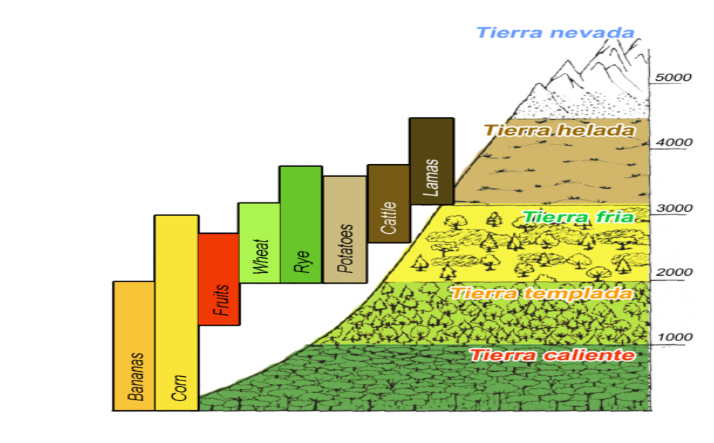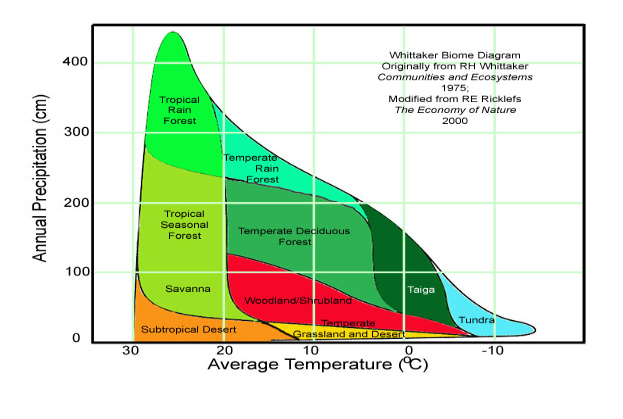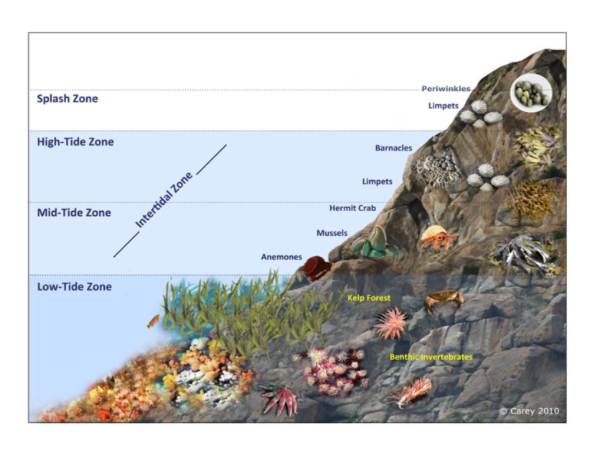2.5 Zonation, succession and change in ecosystems
1/19
There's no tags or description
Looks like no tags are added yet.
Name | Mastery | Learn | Test | Matching | Spaced |
|---|
No study sessions yet.
20 Terms
When will zonation occur
Zonation will occur where there is an environmental gradient (changes in abiotic factors) and can occur on a variety of scales from global (biomes) to very local (moving from the edge of a lake).
Factors that allow zonation to occurred
Elevation, latitude, tidal level
Elevation within zonation
Elevation (Montane Zonation)
This image shows the altitudinal zones of the Andes Mountains and the corresponding communities of agriculture and livestock.
Temperature and oxygen availability are the major abiotic factors determining the zones but ultraviolet radiationmay also be a factor at high altitudes.

Latitude within zonation
Latitude: (Biomes)
Biomes are examples of the effects of changing latitude which impacts the amount of insolation, temperature and precipitation. They are examples of zonation on a global scale.
The image nicely illustrates an activity you can do with the climatographs created in the where you plot the climatograms on a table or wall with the edges of the table or wall representing the axes illustrated here.

Tidal level within zonation
This image shows how as you progress from the sea to land in tidal areas, there are different zones, each with a different set of organisms adapted to the specific conditions found there. Important abiotic factors in determining these zones are wave action, salinity, temp submersion.

Soil horizons within zonation
The image shows typical soil layers or horizons as they are commonly known. each layer has varying proportions of organic and inorganic material, organisms air and water. The combinations of layer is known as a soil profile and varies with many factors including human impact or climate.

Distance from a water source within zonation
Distance from a water source. As you progress into a lake from the areas surrounding the lake there will be changes in soil humidity, oxygen availability (for the roots) and as you enter the lake, light availability and temperature. The diagram shows a typical zonation pattern of this nature (along with elevation)for Lakes Manapouri and Te Anau in New Zealand.

What can be used to measure biotic and abiotic factors along an environmental gradient in order to determine the variables that affect the distribution of species
Transects
Changes in abiotic and biotic factors as a result of environmental gradients can be measured scientifically using a "transect" approach. This simplest type of transect involves a tape measure and a quadrat. Random sampling would not be appropriate here as the environmental variables are changing along a gradient so the use of a line transect would allow the sampling to be done systematically.
Why are kite diagrams used
Kite diagrams are used to display the number of animals or percentage cover for plants across a transect. The distribution of organisms in a habitat is influenced by the presence of other living organisms, such as herbivores or predators that might eat them, as well as abiotic factors like availability of light or water. The width of the kite in the diagram represents the number of species in the habitat.
Kite diagrams are commonly used to illustrate the zonation along a transect.
Succession
Succession is the process of change over time in an ecosystem involving pioneer, intermediate and climax communities. This results in changes to the structure and species composition of the communities present.
In some communities, such as sand dunes, all the seres (stages) are present as the succession is a continual process as the bare sand is colonised, but more often there will only be one sere present at one time, such as in the colonisation of a newly created volcanic island.
Difference between zonation and sucession
Sucession is temporal. Zonation is spatial
Pollen records in peat
Peat moss thrives in constantly wet environments and slowly accumulates over time, forming thick layers of peat. These layers act like a natural archive, trapping pollen grains from the surrounding vegetation. By analysing the different types and quantities of pollen preserved in these layers, scientists can reconstruct past vegetation communities. In the Southern Vosges Mountains, Northeastern France, the Grande Pile peat bog gives a continuous pollen sequence for the last 140,000 years. The image shows core samples for pollen analysis taken from natural peatland[3]
Here's how pollen records in peat explain ecological succession:
Pollen Signature of Different Stages: Different plant species produce pollen with distinct characteristics. Analysing the dominant pollen types in each peat layer reveals the major plant communities that existed when that layer formed.
Change Over Time: As we move deeper into the peat layers, representing older times, the pollen composition typically changes. This reflects the shifts in vegetation over time, a hallmark of ecological succession.
Succession Sequence: By following the changes in pollen dominance through the peat profile, scientists can infer the sequence of plant communities that replaced each other over time. For example, a shift from pioneer species like grasses and herbs to pollen indicative of shrubs and then trees might represent the progression from bare ground to a forest ecosystem.
The gradual changes in pollen composition within the peat layers provide a chronological record of how the ecosystem transformed, revealing the pathway of ecological succession. It's like reading a story from the past, written in pollen!
At its most extreme, this sequence of succession starts on bare, uncolonised ground which has never had any vegetation growing on it before or in newly formed lakes. This is known as primary succession. Most bare areas today are exposed because existing vegetation has been destroyed by fire or covered with flood silt or volcanic ash. The vegetation re-colonising the area will be affected by conditions not available in primary succession. This includes the remnants of soil, organic matter, seeds and even some plants which have survived the changes. This sequence of changes on disturbed land is called secondary succession.
Bare areas are rare but they occur on sand dunes, the lava flows of volcanoes, new volcanic islands, landslips and the glacial debris left by melting glacier ices. The remains of glacier tills left by retreating ice sheets and lakes formed in hollows and blocked glacial valleys were very common at the end of the last ice age.
What is the sequence of vegetation types which occur in primary sucession is often called ..
A sere

Sere table
Early phases of primary sucession
Primary Succession occurred on vast expanses of land after the retreat of the last ice age c. 13000 years ago. The study of the early phases of such succession comes from direct observation of recently exposed sites and by investigating fossil pollen records from regions exposed at the end of the last glacier period.
The process of succession usually starts when autotrophs begin to live in the area. The structure and nutrient content of exposed ground will affect which species become the first colonisers.Bare rocky areas are often invaded first by animals such as spiders which can hide in the cracks between boulders. Such animals are carnivorous or scavengers and live by feeding on insects which have been blown in by mistake.
During succession, the patterns of energy flow, gross and net productivity, diversity, and mineral cycling change over time.

Stability of a system
An ecosystem’s capacity to survive change may depend on its diversity and resilience. A newly formed pioneer community will have very simple communities with short food chains and limited resilience to change. A more mature climax community may have more complex communities and therefore greater resilience.
However, ancient climax communities in environments which are harsh may have simpler communities and lower resilience.
The image shows a trail on sedge–tussock tundra. Made by camp vehicles in 1984 and photographed in 2005, the trail was still visible after 21 years because it had fewer evergreen shrubs and more sedges than surrounding tundra. Credit, U.S. Fish and Wildlife Service.
Here is a basic causal loop diagram to depict the interplay of the key concepts of stability, diversity, succession and human impact. Effects can be direct (solid line) or indirect (dashed line)

Example: Surtsey Island
Surtsey is a volcanic island near Iceland that emerged from the ocean in 1963. Since then, it's become a hotspot for studying primary succession
Initial colonisation by pioneer species:Lichens and mosses arrive via wind dispersal and bird droppings, establishing themselves on the barren volcanic rock. These pioneering species are adapted to withstand harsh conditions like high winds, salt spray, and minimal nutrients.
Primary successional processes:Lichen and moss decomposition: As lichens and mosses die, they decompose over time, contributing organic matter to the new substrate. This initial layer of organic matter helps trap windblown particles, aiding in the formation of rudimentary soil. Nitrogen fixation: Certain pioneer mosses have a symbiotic relationship with nitrogen-fixing bacteria. These bacteria convert atmospheric nitrogen into a usable form, enriching the developing soil.
Establishment of vascular plants:With the formation of a thin layer of soil and some trapped nutrients, seeds of grasses, herbs, and other vascular plants arrive by wind and bird dispersal. These plants can establish themselves due to the slightly more favourable conditions.
Increased organic matter: The vascular plants contribute significantly more organic matter to the soil as they die and decompose, further enriching the soil and enabling the establishment of more complex plant communities.
Development of shrubland: As the soil matures and conditions become more favourable, hardier shrubs like sea campion (Silene uniflora) can take root. The presence of these shrubs alters the microclimate, creating more sheltered areas suitable for other plant species.
Succession towards a more complex climax ecosystem: The arrival of insects, birds, and even seals introduces new dispersers for seeds and propagates further colonisation. These animals also contribute to nutrient cycling and soil development. Over time, this progressive development paves the way for a more diverse and complex ecosystem to establish itself on Surtsey.
It's important to note that succession on Surtsey is an ongoing process, and the island's ecosystem is still young in ecological terms. Scientists continue to study the island to gain a better understanding of how primary succession works and how ecosystems develop over time.
What is secondary sucession
Secondary ecological succession establishes itself on disturbed areas with pre-existing soil, where a previous community once thrived. Examples include abandoned agricultural fields or forests recovering after wildfires.